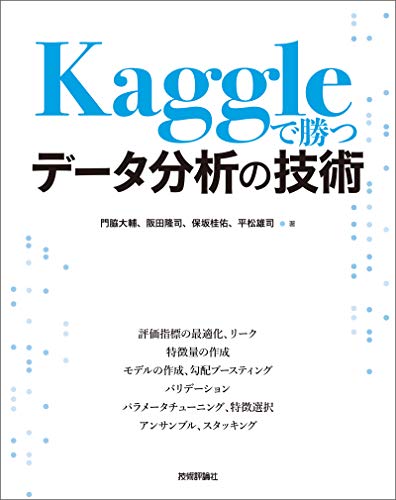XGBoost は同じデータセットとパラメータを用いた場合、学習に使うデータの量 (行数) と最適なイテレーション数が線形な関係にあることが経験的に知られている 1。 今回は、それが同じ GBDT (Gradient Boosting Decision Tree) の一手法である LightGBM にも適用できる経験則なのかを実験で確認する。
使った環境は次のとおり。
$ sw_vers ProductName: macOS ProductVersion: 11.2.3 BuildVersion: 20D91 $ python -V Python 3.9.2 $ pip list | grep -i lightgbm lightgbm 3.2.0
もくじ
下準備
あらかじめ、必要なパッケージをインストールしておく。
$ pip install lightgbm scikit-learn seaborn
実験
以下に、実験用のサンプルコードを示す。
サンプルコードでは、sklearn.datasets.make_classification() を使って生成した擬似的な二値分類用のデータセットを使っている。
生成したデータセットから、一定の割合で学習用のデータを無作為抽出して、LightGBM のモデルを学習したときの特性を確認している。
なお、性能の評価は念のため Nested Validation (outer: stratified hold-out, inner: stratified 5-fold cv) にしている。
outer の予測には inner で学習させたモデルで averaging している。
#!/usr/bin/env python3 # -*- coding: utf-8 -*- from __future__ import annotations import time import numpy as np import pandas as pd import lightgbm as lgb import seaborn as sns from matplotlib import pyplot as plt from sklearn.datasets import make_classification from sklearn.model_selection import train_test_split from sklearn.model_selection import StratifiedKFold from sklearn.metrics import log_loss def main(): # 疑似的な教師信号を作るためのパラメータ dist_args = { # データ点数 'n_samples': 100_000, # 次元数 'n_features': 100, # その中で意味のあるもの 'n_informative': 20, # 重複や繰り返しはなし 'n_redundant': 0, 'n_repeated': 0, # タスクの難易度 'class_sep': 0.65, # 二値分類問題 'n_classes': 2, # 生成に用いる乱数 'random_state': 42, # 特徴の順序をシャッフルしない (先頭の次元が informative になる) 'shuffle': False, } # 教師データを作る x, y = make_classification(**dist_args) # Nested Validation (stratified hold-out -> stratified 5 fold cv) train_x, test_x, train_y, test_y = train_test_split(x, y, test_size=0.3, stratify=y, shuffle=True, random_state=42, ) folds = StratifiedKFold(n_splits=5, shuffle=True, random_state=42) # 学習用のパラメータ lgb_params = { # タスク設定 'objective': 'binary', # メトリック 'metric': 'binary_logloss', # 乱数シード 'seed': 42, } # 乱数シードを設定する np.random.seed(42) sampled_rows = [] best_iterations = [] test_metrics = [] learning_times = [] sampling_rates = np.arange(0.1, 1.0 + 1e-2, 0.1) for sampling_rate in sampling_rates: train_len = len(train_x) sampled_len = int(train_len * sampling_rate) sampled_rows.append(sampled_len) # 重複なしで無作為抽出する (本当はここも Stratified にした方が良い) sampled_indices = np.random.choice(np.arange(train_len), size=sampled_len, replace=False) sampled_train_x = train_x[sampled_indices] sampled_train_y = train_y[sampled_indices] train_dataset = lgb.Dataset(sampled_train_x, sampled_train_y) # 交差検証 start_time = time.time() cv_result = lgb.cv(params=lgb_params, train_set=train_dataset, num_boost_round=10_000, early_stopping_rounds=100, verbose_eval=100, folds=folds, return_cvbooster=True, ) end_time = time.time() learning_time = end_time - start_time learning_times.append(learning_time) cvbooster = cv_result['cvbooster'] best_iterations.append(cvbooster.best_iteration) # Fold Averaging でテストデータのメトリックを計算する pred_y_folds = cvbooster.predict(test_x) pred_y_avg = np.array(pred_y_folds).mean(axis=0) test_metric = log_loss(test_y, pred_y_avg) test_metrics.append(test_metric) # 生の値 data = { 'sampling_rates': sampling_rates, 'sampled_rows': sampled_rows, 'best_iterations': best_iterations, 'learning_times': learning_times, 'test_metrics': test_metrics, } df = pd.DataFrame(data) print(df) # グラフにプロットする fig = plt.figure(figsize=(8, 12)) ax1 = fig.add_subplot(3, 1, 1) sns.lineplot(data=df, x='sampling_rates', y='best_iterations', label='best iteration', ax=ax1, ) ax1.grid() ax1.legend() ax2 = fig.add_subplot(3, 1, 2) sns.lineplot(data=df, x='sampling_rates', y='learning_times', label='learning time (sec)', ax=ax2, ) ax2.grid() ax2.legend() ax3 = fig.add_subplot(3, 1, 3) sns.lineplot(data=df, x='sampling_rates', y='test_metrics', label='test metric (logloss)', ax=ax3, ) ax3.grid() ax3.legend() plt.show() if __name__ == '__main__': main()
上記を実行してみよう。 計算リソースにもよるけど、それなりに時間がかかるはず。
$ python lgbiter.py [LightGBM] [Info] Number of positive: 2764, number of negative: 2836 [LightGBM] [Warning] Auto-choosing col-wise multi-threading, the overhead of testing was 0.003497 seconds. You can set `force_col_wise=true` to remove the overhead. [LightGBM] [Info] Total Bins 25500 ... [1500] cv_agg's binary_logloss: 0.118727 + 0.00302704 [1600] cv_agg's binary_logloss: 0.118301 + 0.00281247 [1700] cv_agg's binary_logloss: 0.117938 + 0.00278925 sampling_rates sampled_rows best_iterations learning_times test_metrics 0 0.1 7000 342 6.734761 0.189618 1 0.2 14000 634 12.412657 0.157727 2 0.3 21000 849 18.421927 0.134406 3 0.4 28000 1018 22.645187 0.129939 4 0.5 35000 1162 27.784236 0.122941 5 0.6 42000 1327 33.731716 0.115750 6 0.7 49000 1567 42.821615 0.113003 7 0.8 56000 1614 48.171218 0.109459 8 0.9 63000 1650 60.064258 0.107337 9 1.0 70000 1681 63.199017 0.104814
完了すると、以下のようなグラフが得られる。

グラフから、LightGBM においても学習に使うデータ量と最適なイテレーション数は概ね線形な関係にあることが確認できた。 また、学習に使うデータ量と学習にかかる時間に関しても概ね線形な関係にあることが見て取れる。 一方で、学習に使うデータが増えても予測精度は非線形な改善にとどまっており、この点も直感には反していない。
いじょう。

- 作者:Jung Kweon Woo
- 発売日: 2020/12/28
- メディア: Kindle版

